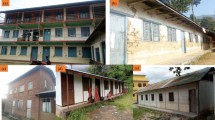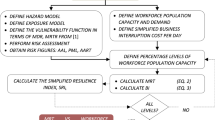Abstract
This paper presents a methodology to quantify a proposed parameter defined as expected annual seismic resilience, which takes into account all possible events that affect a site of interest by following the next steps: (1) definition of seismic hazard, (2) definition of the exposure database, (3) computation of structural and human vulnerability, (4) estimation of seismic risk, (5) definition of rehabilitation strategies and (6) estimation of repairing times and required resources in the proposed rehabilitation process. In this study, consequential physical losses and indirect cost are not considered in the resilience computation. The methodology is applied to a case study of existing school buildings, located in Mexico City given its important seismic activity. The results are presented in annual resilience maps that will allow to graphically observe the distribution of resilient structures and use this information to take better decisions in disaster prevention and response. From this research it was found that a large percentage of the studied school buildings do not achieve an acceptable annual resilience value according to the rating proposed, which is important, since the seismic design codes do not explicitly consider resilience concepts. However, with the information of expected annual seismic resilience values in Mexico City, obtained in this research, it is possible to identify those buildings that require immediate attention associated to the lower resilience values so that they may be taken into consideration in the decision-making process of disaster prevention and response.

(adaptation from Cimellaro et al. 2010)











Similar content being viewed by others
References
Almufti I, Willford M (2013) REDiTM rating system: resilience-based earthquake design initiative for the next generation of buildings. Technical report, Version 1.0. Arup, San Francisco, CA, 134 pp
Anwar G, Dong Y, Zhai C (2019) Performance-based probabilistic framework for seismic risk, resilience, and sustainability assessment of reinforced concrete structures. Adv Struct Eng 19(3):970–977
Avelar C, Veras L, Hernandez J (2004) Structural assessment during the leveling procedure on masonry buildings in Mexico. SMIE, Acapulco (in Spanish)
Biondini F, Camnasio E, Titi A (2015) Seismic resilience of concrete structures under corrosion. Earthq Eng Struct Dyn 44:2445–2466
Bird J, Sancio R, Bray J, Bommer J (2004) The ground failure component of earthquake loss estimations: a case study of Adapazari, Turkey. In: 13th World, conference on earthquake engineering, Paper No. 803
Bray J, Stewart J, Baturay M, Durgunoglu T, Onalp A, Sancio R, Stewart JP, Ural D, Ansal A, Bardet JB, Barka A, Boulanger R, Cetin O, Erten D (2000) Damage patterns and foundation performance in Adapzari. Earthq Spectra 16:163–189
Bruneau M, Reinhorn A (2007) Exploring the concept of seismic resilience for acute care facilities. Earthq Spectra 23(1):41–62
Bruneau M, Chang S, Eguchi R, Lee G, O’Rourke T, Reinhorn A, Shinozuka M, Tierney K, Wallace W, Von Winterfeldt D (2003) A framework to quantitatively assess and enhance the seismic resilience of communities. Earthq Spectra 19(4):733–752
Chang SE, Shinozuka M (2004) Measuring improvements in the disaster resilience of communities. Earthq Spectra 20(3):739–755
Cimellaro G, Reinhorn A, Bruneau M (2005) Seismic resilience of a health care facility. In: Proceedings of annual meeting of the Asian Pacific network of centers for earthquake engineering research (ANCER), 10-13 November 2005, Seogwipo KAL Hotel, Jeju, Korea, paper N3-Sesion III
Cimellaro G, Reinhorn A, Bruneau M (2010) Framework for analytical quantification of disaster resilience. Eng Struct 3639–3649
DDF, Departamento del Distrito Federal (1976) Building code for the federal district. Official Gazette of the Federal District Department (in Spanish)
DDF, Departamento del Distrito Federal (1987) Building code for the Federal District. Official Gazette of the Federal District Department (in Spanish)
El Universal (2017) Consulted Online February 10, 2020. https://www.eluniversal.com.mx/metropoli/cdmx/hay-26-ninos-fallecidos-y-30-desaparecidos-en-derrumbe-de-escuela-rebsamen-pena-nieto
ERN-AL (2010) CAPRA, compressive approach for probabilistic risk assessment. World bank, Inter-American Development Bank. www.ecapra.org
Excelsior (2011) Consulted Online 29 June 2016. http://www.excelsior.com.mx/2011/09/19/comunidad/769082
FEMA, Federal Emergency Management Agency (2012) P-58-1, Seismic Performance Assessment of Buildings, Redwood City
FEMA, Federal Emergency Management Agency (2012) P-58-3, Seismic Performance Assessment of Buildings, Redwood City
Gebelein J, Barnard M, Burton H, Cochran M, Haselton C, McLellan R, Porter K (2017) Considerations for a framework of resilient structural design for earthquakes. In: 2017 Structural Engineers Association of California Convention Proceedings
GDF, Gobierno del Distrito Federal (2004a) Building Code for the Federal District. Official Gazette of the Federal District Government (in Spanish)
GDF, Gobierno del Distrito Federal (2004b) Complementary technical norms for seismic design. Official Gazette of the Federal District Government (in Spanish)
González C (2018) Estimation of seismic resilience on public school buildings, Master Thesis, Master in Civil Engineering Program, National University of Mexico
Hashemi M, Al-Attraqchi A, Kalfat R, Al-Mahaidi R (2019) Linking seismic resilience into sustainability assessment of limited-ductility RC buildings. Eng Struct 188:121–136
Ibarra LF, Medina RA, Krawinkler H (2005) Hysteretic models that incorporate strength and stiffness deterioration. Earthq Eng Struct Dyn 34:1498–1511
INEGI, National Institute of Statistics and Geography (2017) Affectation statistics due to the 2017 September earthquakes in the economical activities, Press Communication 419/17, 13 pp (in Spanish)
Jaimes MA, Niño M (2017) Cost-benefit analysis to assess seismic mitigation options in Mexican public school buildings. Bull Earthq Eng 15:3919–3942
Kafali C, Grigoriu M (2005) Rehabilitation decision analysis. In: ICOSSAR’05. Proceedings of the ninth international conference on structural safety and reliability, Buffalo
Lignos DG, Krawinkler H (2013) Development and utilization of structural components database for performance-based earthquake engineering. J Struct Eng 139(8):1382–1394
Manos G, Stravroy D, Dimoshthenous M, Kourtides B (2004) Experimental and analytical investigation of repaired and strengthened reinforced concrete structural elements utilizing CFRP. In: 13th World conference on earthquake engineering
Olivová K, Bilcík (2009) Strengthening of concrete columns with CFRP. Slovack J Civ Eng 17(1):1–9
Ordaz M, Martinelli F, Aguilar A, Arboleda J, Meletti C, D’Amico V (2015) CRISIS2015, Program for Computing Seismic Hazard
Park Y, Ang A (1985) Mechanistic seismic damage model for reinforced concrete. J Struct Eng 111(4):722–739
Pham TM, Doan VL, Hadi MN (2013) Strengthening square reinforced concrete columns by circularization and FRP confinement. Constr Build Mater 49:490–499
Porter K (2018) A Beginner’s guide to fragility, vulnerability and risk. University of Colorado Boulder, Denver
Reinoso E, Jaimes M, Esteva L (2018) Estimation of life vulnerability inside buildings during earthquakes. Struct Infrastruct Eng 14:1140–1152
Renschler CS, Frazier AE, Arendt LA, Cimellaro GP, Reinhorn AM, Bruneau M (2010) Developing the “PEOPLES” resilience framework for defining and measuring disaster resilience at the community scale. In: Proceedings of the 9th U.S. National and 10th Canadian conference on earthquake engineering
Rosenblueth E, Ordaz M, Sánchez-Sesma FJ, Singh SK (1989) The Mexico earthquake of September 19, 1985—Design spectra for Mexico’s Federal District. Earthq Spectra 5:273–291
Rosseto T, D’Ayala D, Ioannou I, Meslem A (2014) Evaluation of existing fragility curves. In: SYNER-G: Typology definition and fragility functions for physical elements at seismic risk. Springer, Dordrecht
Ruiz-Garcia J, Miranda E (2002) Evaluation of approximate methods to estimate maximum inelastic displacement demands. Earthq Eng Struct Dyn 31:539–560
Samadian D, Ghafory-Ashtiany M, Naderpour H, Eghbali M (2019) Seismic resilience evaluation based on vulnerability curves for existing and retrofitted typical RC school buildings. Soil Dyn Earthq Eng 127:1–30
Sánchez A (2017) Five dead people and 40 injured in the Monterey Institute of Technology. La Jornada. Retrieved 20 Sept 2017
SEP (2015) Consulted online 03 January 2015. https://www.planeación.sep.gob.mx/Doc/estadística_e_indicadores/principales_crifras
SEP (2017) Consulted online 26 November 2017. https://www.gob.mx/sep/articulos/actualizacion-de-planteles-afectados-por-sismo-e-informe-sobre-la-suspension-de-clases
Shereen H, Mu’tasime A, Maha A (2018) Rehabilitation of reinforced concrete deep beams using carbon fiber reinforced polymers. Mod Appl Sci 12(8):179–194
Teran GA, Jirsa J (2005) A damage index for practical seismic design that accounts for low cycle-fatigue. Earthq Spectra 21:803–832
Vamvatsikos D, Cornell CA (2002) Incremental dynamic analysis. Earthq Eng Struct Dyn 31(3):491–514
Yamin L, Rincón J, Fernández R, García A, Reyes J (2018) Repair cost and downtime seismic vulnerability assessment for RC school buildings. In: Proceedings of the Eleventh U.S. National Conference on Earthquake Engineering. Los Angeles
Yeow T (2017) Building-specific seismic resilience assessment frameworks considering content sliding and injury. Ph.D. Thesis, Department of Civil and Natural Resources Engineering, University of Canterbury, Christchurch
Acknowledgements
The authors acknowledge the DGAPA-UNAM for the Grant of Project PAPIIT-IN115418 “Propose of a methodology for the structural seismic resilience assessment of the public scholar infrastructure”. Furthermore, the authors thank National Council of Science and Technology (CONACyT) for the sponsorship of the Project No. A1-S-35223 “Seismic demands definition for the risk and resilience-based design of structures” and for the graduate scholarship of the first author.
Author information
Authors and Affiliations
Corresponding author
Additional information
Publisher's Note
Springer Nature remains neutral with regard to jurisdictional claims in published maps and institutional affiliations.
Rights and permissions
About this article
Cite this article
González, C., Niño, M. & Jaimes, M.A. Event-based assessment of seismic resilience in Mexican school buildings. Bull Earthquake Eng 18, 6313–6336 (2020). https://doi.org/10.1007/s10518-020-00938-5
Received:
Accepted:
Published:
Issue Date:
DOI: https://doi.org/10.1007/s10518-020-00938-5




